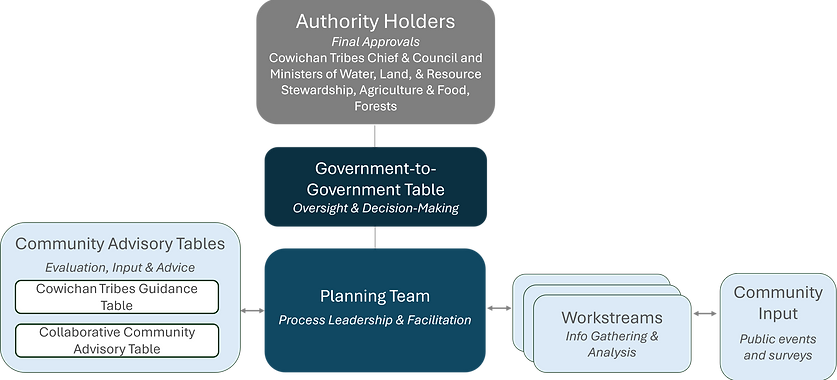HOW WE'RE ORGANIZED
Planning Process
The planning process will follow a structured and transparent approach to work through decisions, with the goal of reaching consensus. People in the watershed have different values, perspectives and beliefs. The planning process will focus on helping people learn together about how different values may be impacted in a water scarce future, and about what is possible in terms of solutions. The process will develop a shared understanding based on the best evidence of the consequences (anticipated impacts and benefits) of different actions that could be taken.
To support this, for each decision or set of decisions that will be made in developing the plan, the process will work through the following steps:
-
Clarify the decision or question to be addressed
-
Develop a clear set of goals and measures (then used to develop and evaluate options),
-
Identify a range of potential options that could be undertaken (different courses of action)
-
Undertake assessment of the likely consequences of each option with respect to goals
-
Deliberate about trade-offs and uncertainties and, where possible, reach consensus
This structured approach will facilitate shared learning and enable open and informed deliberations about key trade-offs and uncertainties. It will enable difficult decisions to be made with full recognition and shared understanding of the impacts and costs to people, governments, and ecosystems.
The stages of planning are summarized in the Figure below. This figure shows how we are moving from ‘tree-top’ (high-level) to ‘understory’ (operational details).

ORGANIZATIONAL STRUCTURE

Cowichan Tribes and the Province of BC have created a structure for working together, gathering information and advice, and making final decisions.
Primary Tables
The structure includes four main tables which meet regularly to guide the planning (and eventual implementation) of the Watershed plan:
A Government-to-Government (G2G) Table: This table, comprised of senior staff from Cowichan Tribes and the Government of BC, makes shared decisions about the Watershed Plan and provides oversight and strategic direction to the planning process.
A Planning Team: Led by a jointly appointed Executive Director and comprised of Cowichan Tribes and Province of BC Planning Leads and support staff, the Planning Team manages and oversees the planning process. The Team is responsible for iteratively drafting the Plan, bringing evidence, draft plan content and recommendations to Advisory Tables and the G2G Table.
Xwulqw’selu Cowichan Community Guidance Group: This forum provides an avenue for Cowichan Tribes members, including Elders and knowledge holders, to reflect and discuss key planning issues, and provide recommendations to the G2G Table on the content of the Watershed Plan.
A Collaborative Community Advisory Table (CCAT): The CCAT represents a diverse range of Watershed interests. The group will participate in a series of workshops between 2023-2026 to work through the steps of the planning process and provide recommendations to the G2G Table.
In addition to these tables, the Planning Team will organize and oversee topic-specific workstreams to advance technical and engagement work in support of the development and evaluation water and land options. How different workstreams are organized, and who is involved, depends on the questions the workstream is asking, its scope, the timeline, and target completion date.
DECISION MAKING
Under the Government-to-Government Agreement, each partner (Cowichan Tribes and BC) is an equal authority with distinct laws and responsibilities. Cowichan Tribes and the Province of BC share a responsibility to protect the Xwulqw’selu Watershed and will work in partnership to make shared decisions regarding sustainable watershed management. Both parties are committed to developing a long-term plan that ensures a healthy Watershed for those who rely on it now, and for generations to come.
Decisions will be informed by both Indigenous and non-Indigenous advisory tables as well as topic specific working groups and other public input.
In 2026, the governments will make a recommendation to Cowichan Tribe Chief & Council, and to the Provincial Ministers who are signatories to S-xats-thut st to realize a shared Government-to-Government vision and priorities for a healthy watershed, healthy communities, and climate-resilient future.




